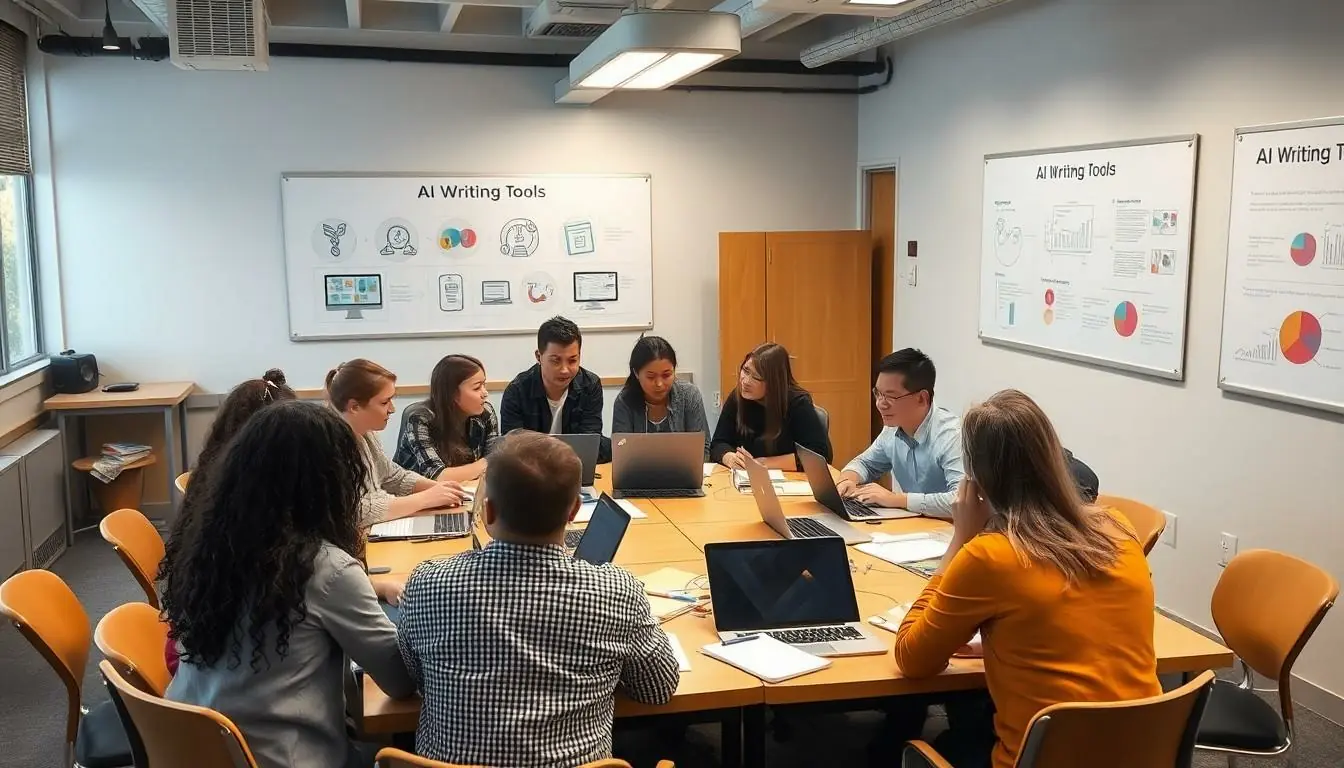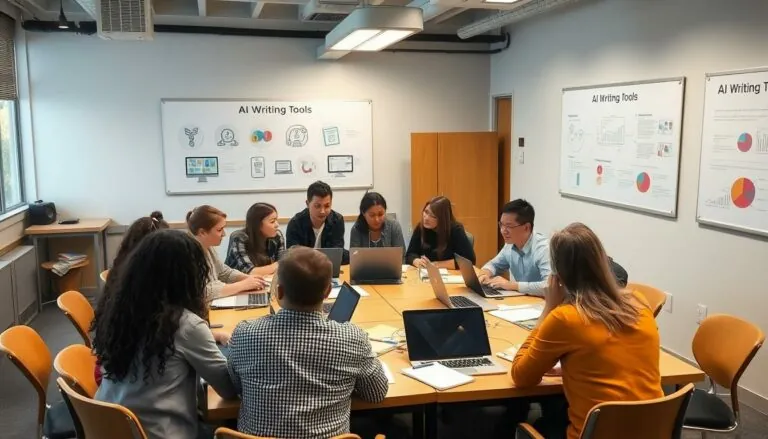In a world where artificial intelligence can whip up essays faster than a caffeine-fueled college student on deadline, it’s only natural to wonder: can you really tell if an essay was penned by ChatGPT? Picture this: you’re grading papers, and one stands out like a sore thumb—smooth language, flawless structure, and a hint of that uncanny valley vibe. Is it a brilliant student or a clever chatbot?
As the lines blur between human and machine writing, knowing the telltale signs of AI-generated content becomes crucial. Whether you’re an educator trying to maintain academic integrity or a curious reader wanting to spot the difference, this exploration promises to be both enlightening and entertaining. Buckle up as we dive into the quirks and clues that reveal the true authorship of those digital wordsmiths.
Table of Contents
ToggleOverview of AI Writing Tools
AI writing tools have rapidly evolved, showcasing impressive capabilities in generating coherent and contextually relevant text. Various platforms, including ChatGPT, analyze input prompts and produce responses that resemble human writing. Such advancements enhance efficiency in content creation but pose challenges in distinguishing between human and AI authorship.
Several AI writing tools exist, each offering unique features. ChatGPT, developed by OpenAI, leverages large language models to generate text on diverse topics. Jasper AI focuses on marketing content, providing templates for blog posts and social media. Grammarly, while primarily an editing tool, uses AI to suggest improvements in writing style and clarity.
These tools rely on algorithms trained on vast datasets, allowing them to mimic human thought patterns and writing styles. Output often contains structured arguments and varied vocabulary, making it plausible that a human author could have crafted the text. Users benefit from these tools, as they save time while enhancing the quality of their writing.
Educational institutions and businesses face challenges due to the proliferation of AI-generated content. Determining authorship becomes crucial for upholding academic integrity and ensuring originality in professional documents. Techniques for identifying AI-generated essays include analyzing text for repetition, stylistic consistency, and logical flow.
Monitoring the impact of AI writing tools requires ongoing evaluation. Adapting to these innovations becomes essential for educators, employers, and writers alike. Awareness of how these technologies operate can help users integrate AI tools effectively while recognizing the importance of maintaining authenticity in written work.
Understanding ChatGPT

ChatGPT, a prominent AI language model, plays a significant role in content generation. This tool utilizes vast datasets to produce coherent text that mirrors human writing.
What Is ChatGPT?
ChatGPT is an AI-powered writing assistant developed by OpenAI. This model generates text based on input prompts, maintaining context and coherence throughout its responses. Users across various fields, from education to marketing, leverage ChatGPT for enhanced productivity. Its ability to adapt stylistically to different requirements makes it an invaluable resource for creating diverse types of written content.
How ChatGPT Works
ChatGPT operates on an advanced neural network architecture known as the transformer model. This architecture allows the model to understand complex language patterns and relationships. It predicts the next word in a sentence based on context, generating responses that often flow naturally. Continuous learning from user interactions enhances its ability to create relevant text quickly. The incorporation of reinforcement learning further refines its outputs, aligning them with human preferences and expectations.
Identifying AI-Generated Content
Distinguishing between human-written essays and those created by AI requires careful attention to specific traits. Certain key characteristics often signal AI authorship.
Key Characteristics of AI Writing
Repetitiveness in word choice can indicate AI involvement. AI-generated content shows patterns with reused phrases or ideas throughout the text. Unusual coherence across various topics also suggests AI authorship. ChatGPT maintains structure and consistency that may not reflect a human’s natural variability. A lack of personal anecdotes or emotional depth further distinguishes AI writing. Essays lacking unique perspectives often signal AI generation.
Differences Between Human and AI Writing Styles
Humans typically express thoughts with varied sentence lengths and stylistic nuances. In contrast, AI writing often features more uniform sentence structures. An emotional connection frequently present in human essays tends to be absent in AI-created outputs. AI content may lack the subtlety and complexity of human writing, resulting in less engaging prose. When paraphrasing, AI exhibits less creativity compared to human authors, relying on recognizable patterns. Analyzing these differences helps inform judgments about authorship.
Tools for Detection
Various tools assist in detecting AI-generated essays. Users can leverage these applications to differentiate between human and AI writing more effectively.
Available Software and Applications
Popular software for detection includes Turnitin, Copyscape, and OpenAI’s own text classifier. Turnitin analyzes text for originality, focusing on potential plagiarism. Copyscape highlights content duplication across the web, helping identify AI-generated passages. OpenAI’s text classifier evaluates linguistic features that suggest AI authorship. Each of these tools offers unique strengths in identifying the nuances of AI-written text.
Effectiveness of Detection Tools
Detection tools vary in effectiveness. Turnitin demonstrates high accuracy in identifying similarities between texts, while Copyscape excels at flagging lifted content. OpenAI’s text classifier provides insights into the likelihood of AI authorship, but it isn’t foolproof. Although these tools significantly enhance detection capabilities, the evolving nature of AI technology presents ongoing challenges. Educators and reviewers benefit from using multiple tools to gain comprehensive analysis and reinforce their judgments regarding authorship.
Ethical Considerations
Understanding the ethical implications of AI-generated essays is crucial in today’s educational landscape. As AI tools grow in sophistication, they challenge traditional learning methods and assessment standards.
Implications of AI in Education
AI-generated content raises concerns about academic integrity. Students using AI to complete assignments may undermine their learning experience. Educators face difficulties in assessing true understanding when essays lack personal insight. Institutions may need to revise evaluation methods to address the potential misuse of AI writing tools. Establishing clear guidelines around AI’s role in education becomes imperative to maintain fairness and accountability.
Responsibility of Writers and Educators
Writers play a vital role in ensuring the authenticity of their work. Ethical use of AI tools means understanding their capabilities and limitations. Educators must foster an environment that encourages original thought and creativity, emphasizing the value of personal expression. Implementing training programs on AI literacy helps both writers and educators navigate these evolving challenges responsibly. Open dialogue about the implications of AI can create awareness and promote ethical standards within academic communities.
The ability to discern whether an essay is written by a human or generated by AI like ChatGPT is becoming increasingly crucial. As technology evolves and AI writing tools improve, recognizing the signs of AI authorship is vital for maintaining academic integrity and authenticity in written work.
By understanding the characteristics of AI-generated content and utilizing detection tools, educators and readers can make informed judgments about authorship. Emphasizing the importance of originality and personal expression will help foster a learning environment that values genuine thought. As these challenges persist, ongoing dialogue and training in AI literacy will be essential in navigating the complexities of AI in writing.







